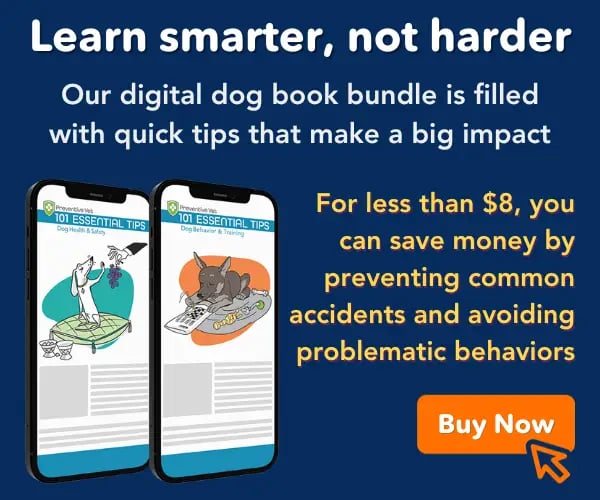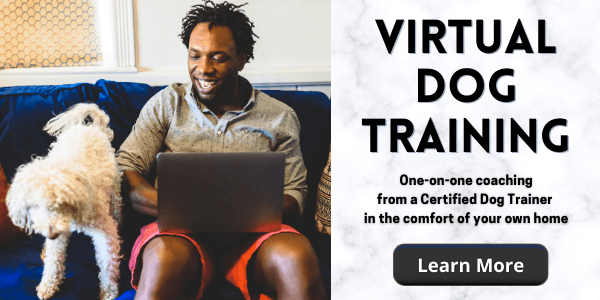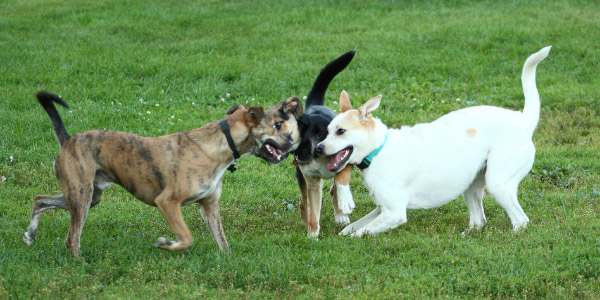 Dog play can seem overwhelming to us humans — dogs will wrestle, chase, and many pups make lots of noise during playtime. Not to mention there’s lots of play biting and teeth-jousting!
Dog play can seem overwhelming to us humans — dogs will wrestle, chase, and many pups make lots of noise during playtime. Not to mention there’s lots of play biting and teeth-jousting!
If your dog has been well socialized and learned how to communicate clearly during play with other dogs, they'll likely be able to enjoy playtime with their dog friends without any issues. But, just like humans, dogs can be unpredictable, and we need to be prepared to step in to keep play safe for all dogs involved, by having them take a quick break from the fun.
When and how do we do this? You have to know how to recognize proper dog play in order to know when it’s escalating into inappropriate play and getting closer to a fight, so you can press pause and allow the dogs to reset.
Skip Ahead
What Does Proper Dog Play Look Like?
Loose and Bouncy
Look for loose and relaxed bodies and faces during dog play; dogs should be nice and floppy in their movements. Dogs make big, exaggerated movements when they're playing. You should see dogs happily falling down and making themselves vulnerable to others; this means they're comfortable enough with their playmate that they aren't worried about exposing their belly.
Vocalizations during play are exaggerated too! Play growling and snarling are prolonged and extra loud, often punctuated by medium to high-pitched barking. Just listen to Polly the Husky mix while she plays with Murphy the Chesapeake Bay Retriever Mix:
Role Reversals
You'll also notice that good playmates switch roles throughout play — at first one is on the bottom during wrestling, and then the other takes a turn underneath. A dog might start as the one being chased, and then turn around and start chasing the other.
Similar to role reversals is when a larger dog self-handicaps during play. This means they make themselves smaller size-wise and lessen the intensity of play to better match a smaller dog playmate. Watch Moose the Malamute puppy handicap himself during play with Ranger the Mini-Aussie:
Lots of Pauses
Polite dog play includes lots of brief pauses to prevent play from escalating into a fight. Some dogs do a great job of managing their own escalation of energy during play by taking pauses during wrestle and chase. These breaks might be so fast that humans will miss them altogether, and sometimes they're longer if the play was getting too rambunctious.
You might also see some calming signals during these quick pauses, which is when one dog says they are getting too worked up and need a moment to "reset", or is telling the other dog that they are being a tad bit overwhelming. Check out this great moment of two puppies taking a quick break and resetting with a clear "shake off" behavior:
Play Bows and Other Play Moves
A play bow is when the dog "bows" at the other dog with their front elbows on the floor and their rear in the air (a lot like the downward dog pose in yoga). This is a signal that is inviting another dog to play or something that happens during play that says "I'm still playing, you're still playing, right?" It provides a nice break for both dogs to catch their breath and reaffirm that they're both on the same page.
You might also see other play body language, like hip bumps and lots of chuffing/sneezing behavior.
Loki the Aussie and April the Boston Terrier show perfect examples of play bows:
Quinn the Pit Mix shows off some great hip bumps during play with Loki the Aussie:
Proper Bite Inhibition
Dogs use their teeth a lot during play with each other, and bite inhibition is imperative for everyone to have a good time. Bite inhibition is when a dog knows how to keep their mouth soft enough to not hurt the other dog while playing, and is something they learn from their littermates, parents, other non-related dogs, and even us!
If a dog bites too hard during play, the other dog will usually communicate by yelping and stopping play. Fights can break out when a dog doesn’t listen to the correction from their playmate, so it’s important for humans to make sure dogs are listening to each other. You can see in this video that there is a lot of "biting" and toothy behavior happening, but bite inhibition is excellent and play continues:
Warning Signs — When to Pause Dog Play
If You Feel Uncomfortable, Press Pause
There is nothing wrong with interrupting dog play if you feel it's getting too crazy. Follow your gut instinct! If it's getting too loud or the wrestling seems too rough, call the dogs away from each other or create a break by taking hold of the dog on top and guiding them away. If the dog that was on the bottom of the wrestling match comes back for more play, then you know they were still comfortable and the play was appropriate.
They might take a moment to catch their breath, shake off and reset before coming back for more, which means the play was on the edge of becoming overwhelming. If they walk away and don't want to engage in more play, then it's time for a longer break between the two or they need a better match for their play style.
Don't feel bad about pressing pause on play — it's better to be safe than sorry!
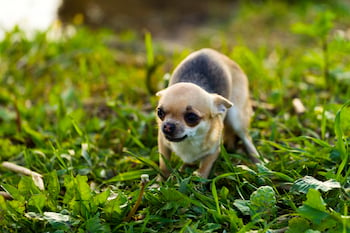 Scared and Submissive Body Language
Scared and Submissive Body Language
If one dog seems especially submissive or worried, they aren’t having fun and should be given some space. You might notice that they keep trying to get away from the other dog — that's your cue to step in and allow them time to relax or remove them from the play area. A tucked tail paired with ears flat against the head is a sign a dog isn't enjoying themselves. You might notice a dog like this will act more defensively and lash out preemptively by baring their teeth or air snapping when another dog approaches.
If you notice a sudden change in your dog's willingness to play and they are more reactive than usual around other dogs, it might be an indication of pain or an underlying injury. Bring them to your veterinarian for an evaluation to make sure that the reason they no longer want to engage in play isn't a medical issue.
Tense and Alert Body Language
If you notice a dog who is very tense and overly focused on one dog, they might be too over-stimulated to play politely. While their intentions might be rooted in play behavior, these dogs tend to overwhelm and annoy the other dog, setting them up for a confrontation. Some signs that a dog is too tense include quick body movements, closed mouth, tall and high body posture, high and tight tail wag, and standing still over another dog.
Change in Vocalization
While loud play vocalizations are normal, listen for any change in the pitch, tone, or volume of the vocalizations. When you get used to what your dog's "normal" play vocalizations sound like, it's easier to notice when it changes so you have a better idea of when to step in and press pause on play.
You'll also want to step in any time there is a dog pestering another with constant barking. While some dogs can be tolerant of demand barking from another during play, allowing that kind of pestering behavior from a dog is only reinforcing it in the long-term, setting the barker up for failure and a lifetime of obnoxious demand barking.
Not Listening to Corrections or Overcorrecting
If a dog is appropriately corrected by another, but doesn't listen and keeps antagonizing the other dog, step in and redirect that dog away.
If a dog overcorrects another dog (for example: gives a correction and the other dog backs away to give them space, but they keep going after that dog) they are overwhelmed and need a break from playtime.
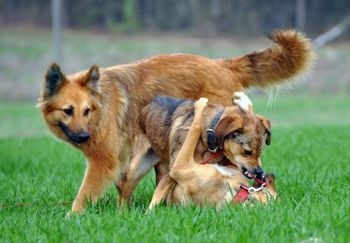 Ganging Up
Ganging Up
Dogs naturally play in pairs. Don't allow multiple dogs to gang up on one dog during play. Even a confident dog can be overwhelmed when on the bottom of a wrestle pile and may lash out defensively. A dog being chased by multiple dogs is a set-up for pack prey-drive instinct to kick in and should be stopped.
Encourage your dog to play with a dog that matches their play style and energy, and redirect their attention if they start ganging up on another dog. If your dog just can't seem to leave another dog or dogs alone, it's time to simply leave the dog park and try again later when there might be a better match.
Safety Concerns
Collars and harnesses can be a safety hazard during dog play. It's easy for a dog's jaw to get stuck on and twist another dog's collar during mouthy play, and this can quickly turn into a life-threatening situation for the dog being strangled. Strangulation by collar is more common than you might think and is a very scary possibility.
If possible, I recommend having dogs play "naked" (sans collar or harness), although this isn't always feasible at places like the dog park. Close supervision and lots of breaks during play are imperative to make sure that dogs don't get tangled up in each other's collars. Having your dog wear a breakaway collar that easily pops open under light pressure is also a great way to ensure their safety.
Never let your dog wear a martingale collar (sometimes called a "limited slip" collar), choke collar, or prong collar while playing. Choke and prong collars should be avoided altogether — read why in "Dog Training Aversives: What Are They and Why You Should Avoid Them."
Press Pause — How to Get Two Dogs to Stop Playing
Redirect Attention
The easiest way to create a break in play is teaching your dog to respond to their name and redirect their attention towards you when they are getting too rambunctious with the other pups, or there are behaviors happening that could lead to a correction.
If you've been practicing your dog's come-when-called cue around distractions, this can also work at the dog park during playtime. Set yourself up for success though, and don't call your dog to come unless you can make it happen. If your dog hasn't mastered their recall around dog park distractions, simply don't call them to come. Use name recognition to encourage a pause in play, or go and get them.
PRO TIP: Practicing your dog's Come-When-Called cue during play is a wonderful way to build the behavior, give you more off-leash control, and create breaks during playtime. The real-life reward for your dog is getting to go back to play! This also helps to prevent your dog from associating "Come!" at the dog park with only being put on leash and leaving.
Making enticing non-verbal noises can also help catch your dog's attention and call them away from play. Watch how this dog, Chase, is called away from humping during play using his name and kissy noises.
Body Blocking
When managing dog play, you can use your body to herd dogs a particular way, preventing them from approaching another dog or enticing them to follow you away. You can simply walk calmly through a group of dogs that are congregating together to diffuse tension — such as when dogs are grouping up in a corner or surrounding a particular dog. Using your body to direct a dog or group of dogs is much easier than trying to grab a collar or harness, and much safer!
Try to keep moving when managing dog play. Staying still can encourage dogs to hang out around you (I swear, they aim for the knees during play ... so always protect your ACLs by keeping your knees bent when around dogs at play!), and this can increase tension which can lead to a scuffle — especially if your dog feels protective of you. Your movement encourages the dogs around you to move, keeping greetings and play fun by providing the opportunity to approach and walk away. Added bonus: you also get a workout by constantly moving during your dog's trip to the dog park!
Getting a Hold of Your Dog
There will be times that you do need to grab a hold of your dog if they're getting too excited and overwhelming another dog during play. Keep this kind of restraint as positive as possible — you don't want your dog to learn that being grabbed and held by the collar or harness is something to try and avoid.
Praise your dog when you get a hold of them, and gently guide them away from the other dog with a happy tone of voice. You might need to move quite a distance away before your dog offers you any attention, but once they do, reward them with lots of pets and praise! If you can, ask for a basic behavior, like a sit, and then release them to go back to play, if appropriate.
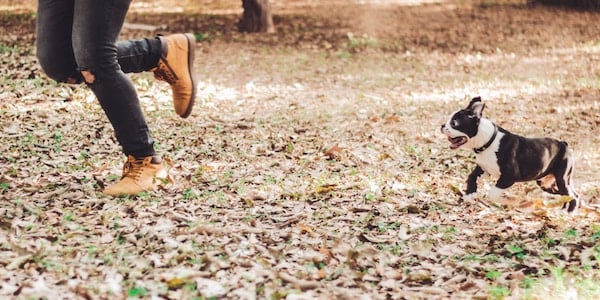
Be Proactive, Not Reactive
When taking your dog out to play with others, whether at the dog park, puppy class, or puppy play date, it's your responsibility to actively manage playtime. Dog park visits are not the right time or place for you to catch up on social media, respond to work emails, or chat on the phone. Almost every scuffle I've seen at dog parks could have been easily prevented if the owners had simply been paying attention and stepped in to manage the play. Take advantage of puppy classes to watch and learn when your trainer steps in during play, and ask lots of questions about what body language and behaviors are appropriate.
Remember, it's okay if your dog doesn't enjoy playing with other dogs. Many puppies start off very dog-social and will engage in play with lots of different dogs, but as dogs mature it's normal for them to become a bit pickier with their playmates or not want to play with other dogs at all. If your dog no longer enjoys playing with others, don't try and force it by taking them to the dog park or other play dates. Such a change could also be an indication that they're suffering pain from arthritis, a pinched nerve, or a host of other potential causes, so also have them evaluated for pain by your veterinarian. (Learn more about detecting pain in dogs.)
It's important to create play breaks PREEMPTIVELY, rather than waiting until a scuffle has already broken out between dogs. It's also a good idea to know how to break up a dog fight safely. If you're proactive in managing the energy during play, you'll be able to prevent bad play experiences and possible dog fights which can cause lasting physical injury and emotional damage. Being engaged with your dog and managing their playtime builds your value in your dog's world and creates stronger positive associations for your dog.


